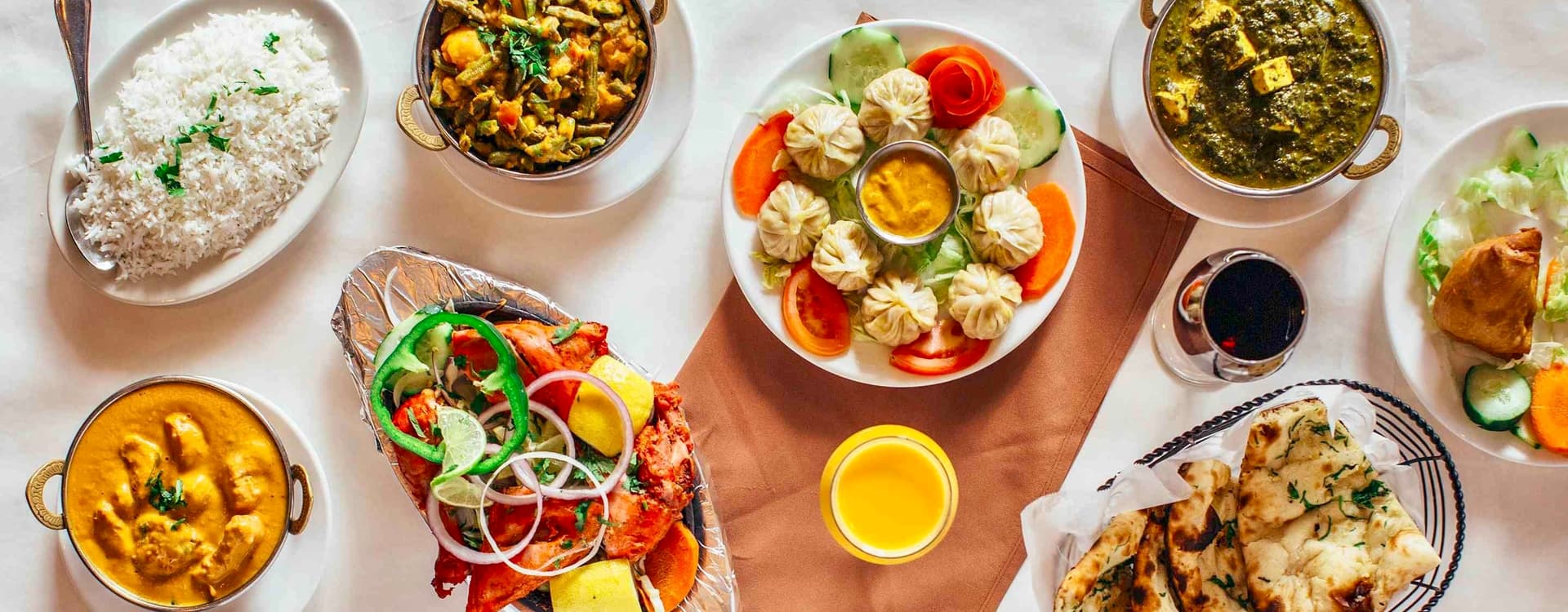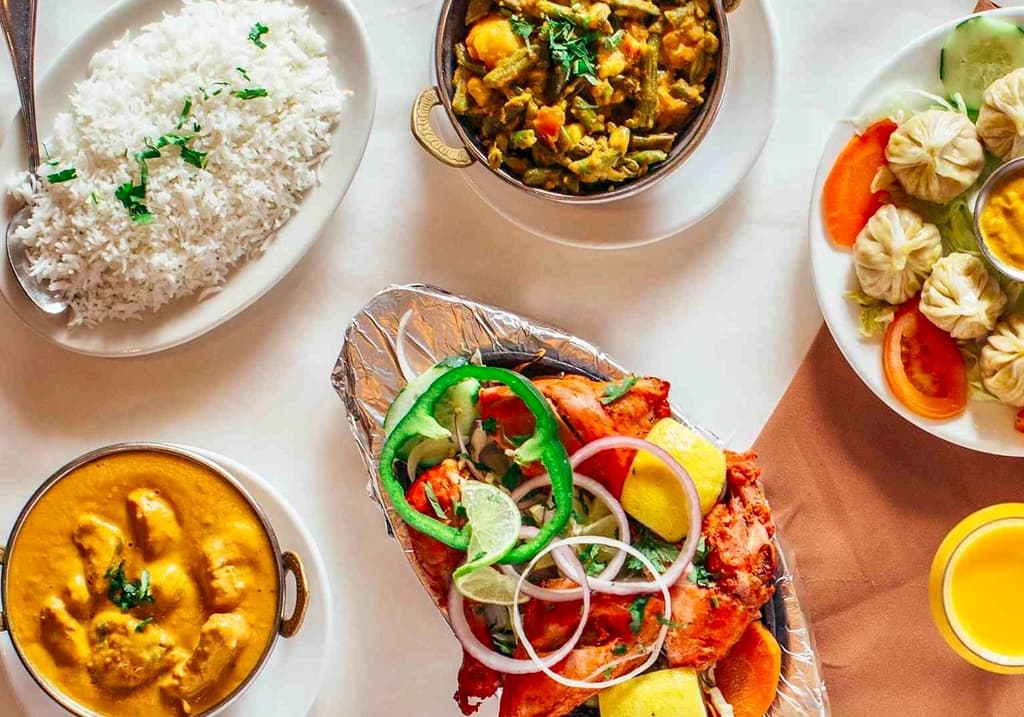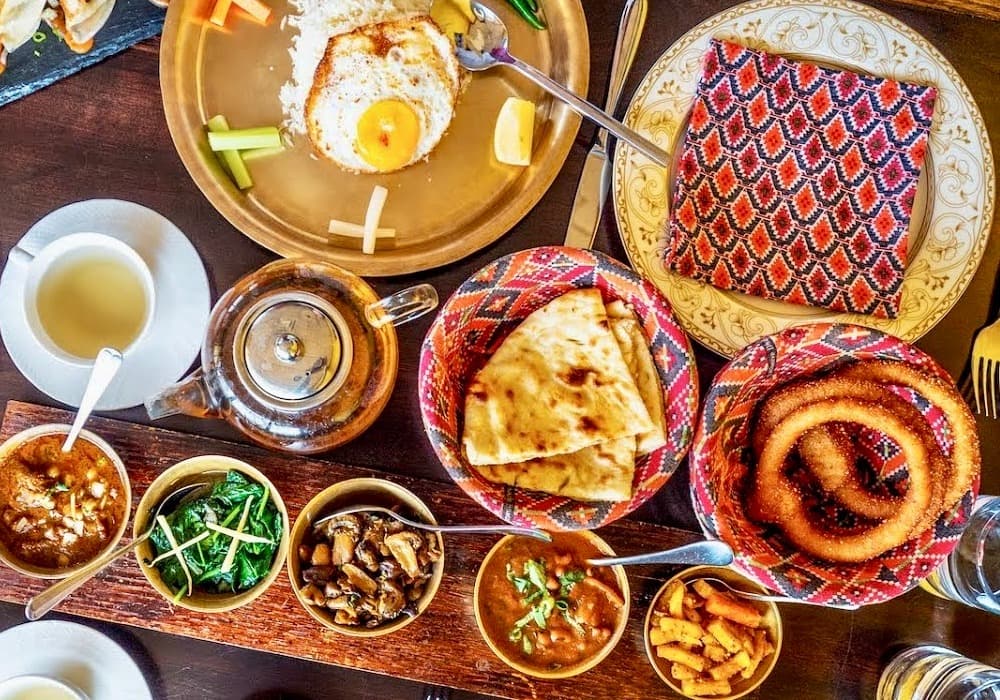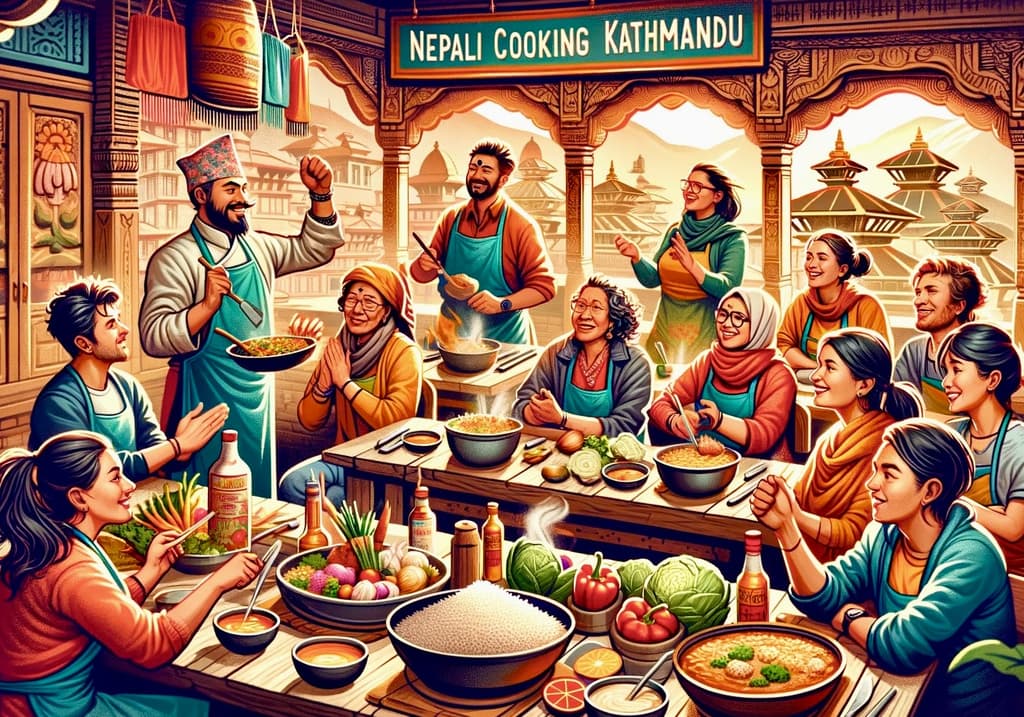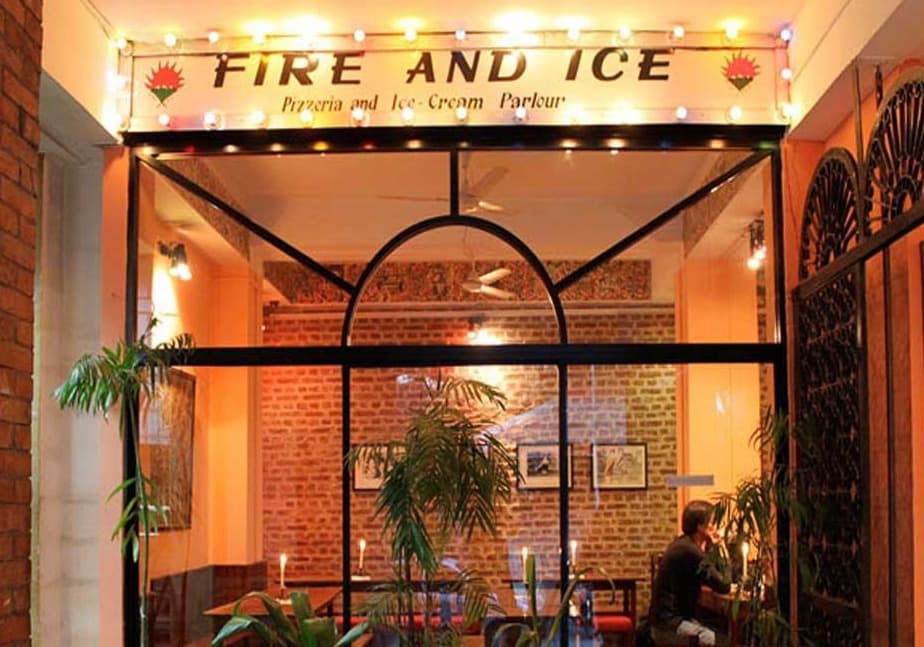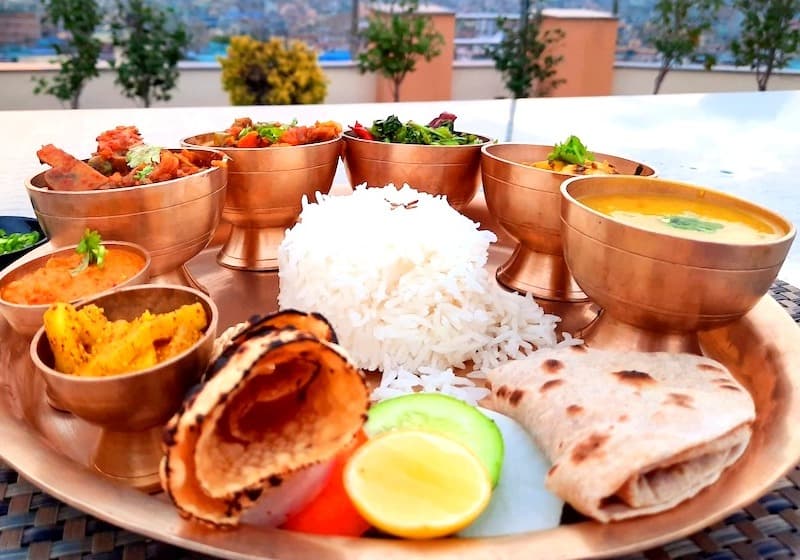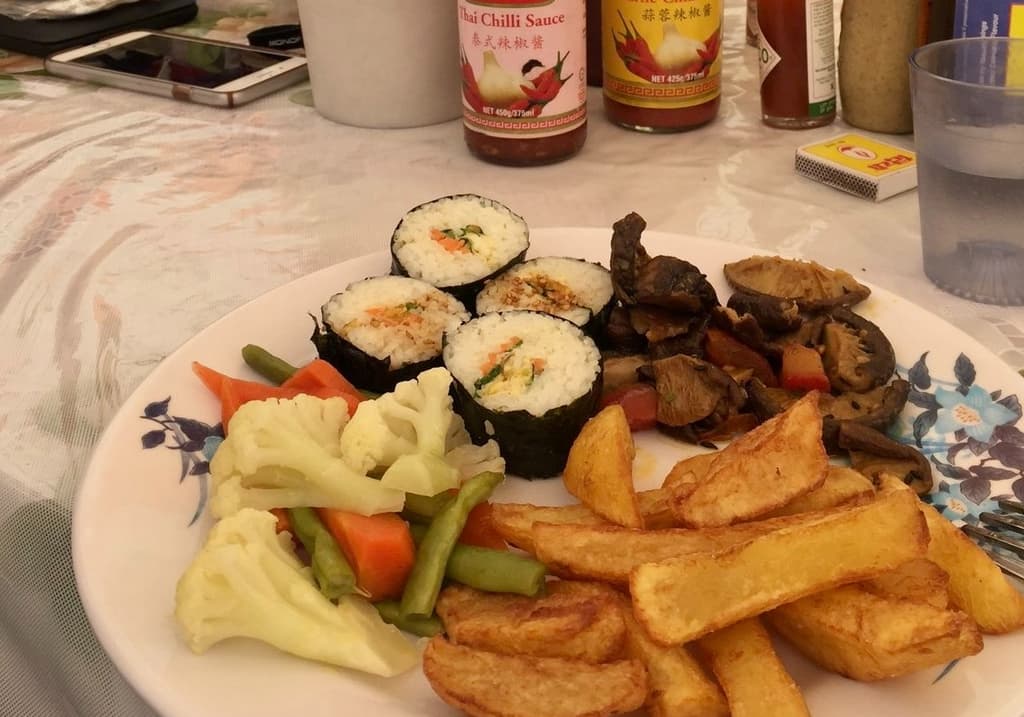Nepal, nestled amidst the towering peaks of the Himalayas, offers more than just breathtaking landscapes and rich cultural heritage. Its culinary landscape is a tantalizing fusion of flavors and textures, drawing influences from its diverse ethnic groups and neighboring countries. Rooted deeply in its traditions and adapted over centuries, Nepali cuisine is a delightful blend of spices, grains, vegetables, and meats, offering a gastronomic journey that is as diverse as its topography. From the hearty staple of Dal Bhat to the mouthwatering Momo dumplings and the warming Thukpa noodle soup, the foods of Nepal are a testament to the country's rich cultural mosaic. Whether you're traversing the bustling streets of Kathmandu or hiking through serene mountain villages, the flavors of Nepal promise to be an integral part of your journey.
Dal Bhat: The Staple of Nepal
At the heart of Nepal's culinary canvas is the iconic Dal Bhat, a dish that symbolizes the country's agricultural heritage and the simple, yet profound, pleasures of its daily life. Literally translating to 'lentil soup' (dal) and 'rice' (bhat), this meal is an embodiment of balanced nutrition and flavors.
The core components of Dal Bhat are steaming white rice accompanied by a bowl of lentil soup, usually made from split lentils that have been boiled and then seasoned with herbs and spices such as turmeric, cumin, garlic, and ginger. The consistency of the lentil soup can vary; some prefer it thick and hearty, while others like it more liquid and brothy.
But Dal Bhat is more than just lentils and rice. It's often served with a plethora of accompaniments. These might include seasonal vegetables stir-fried or curried, spicy chutneys or pickles (achar), and possibly a portion of protein like chicken, mutton, or fish curry. In many instances, a side of fresh greens or a crisp salad, and a dollop of spicy fermented vegetables (kimchi-like side known as 'gundruk') are also added.
For many Nepalis, Dal Bhat isn't just a meal; it's a ritual, consumed twice a day, offering the energy and sustenance required for long hours of work in the fields or navigating the rugged terrains. The dish also holds cultural significance, being a common thread that binds various ethnic communities and regions. Whether in a humble village home, a bustling city eatery, or a mountain teahouse, Dal Bhat is a testament to Nepal's culinary identity, and an absolute must-try for anyone seeking an authentic taste of the nation's heart and soul.
Momo: Nepal’s Beloved Dumplings
In the labyrinth of Nepal's culinary delights, the Momo stands out, not just as a dish but as a cultural phenomenon. These delectable dumplings, which have their origins in Tibet, have seamlessly woven themselves into the fabric of Nepal's food culture, becoming an integral part of its gastronomic identity.
A Momo, at its essence, is a filled dough pocket. The fillings can be diverse – ranging from minced meat like chicken, pork, or buffalo, to finely chopped vegetables. The mixture is seasoned with a medley of spices and herbs, including but not limited to garlic, ginger, turmeric, cilantro, and sometimes a hint of Szechuan pepper, imparting a unique flavor that tantalizes the palate.
The art of Momo-making is in the delicate wrapping, where the filling is enveloped in thin dough sheets. The dough's edges are then meticulously pleated to seal the filling inside. The resultant shape can range from simple half-moons to intricate, round bundles. Once shaped, these dumplings are either steamed to soft perfection or fried to a crispy golden hue.
Accompanying the Momo is a quintessential dipping sauce, often made from tomatoes, chilies, and sesame seeds. This tangy and spicy dip, called 'achar', elevates the Momo-eating experience to another level.
While Momos can be found in many Asian countries, what sets the Nepali Momo apart is its distinct taste, shaped by local ingredients and the love and care that goes into making them. From bustling Kathmandu alleyways with vendors steaming Momos in large vessels to upscale restaurants that have reinvented the Momo with contemporary twists, these dumplings are omnipresent.
Whether enjoyed as a quick snack, a street food delight, or a main course in family gatherings, Momos resonate with warmth, comfort, and a flavor that's unmistakably Nepali. For many, it's not just food; it's a bite-sized piece of nostalgia, evoking memories and emotions with every bite.
Thukpa: Noodles from the Mountains
In the chilly embrace of the Himalayan ranges, where the air is crisp and the terrain rugged, emerges a dish as heartwarming as a mountainous embrace: Thukpa. This noodle soup, which traces its roots to Tibet, has found a beloved home in Nepal, where it's embraced as a soul-soothing delicacy, especially during colder months.
Thukpa is, in essence, a harmonious medley of meat or vegetables, and noodles, all submerged in a flavorful broth. The broth is typically simmered for hours, drawing flavors from various spices, bones (in the case of non-vegetarian variants), and sometimes even local herbs, giving it a depth that's rich and satisfying. Common ingredients include garlic, ginger, green chilies, and a sprinkling of local spices that lend Thukpa its distinctive taste.
The noodles used in Thukpa are usually hand-pulled or hand-rolled, offering a fresh, chewy texture that commercial noodles often lack. These are then combined with a variety of ingredients - from thinly sliced meat (chicken, pork, or beef) to an assortment of fresh vegetables like carrots, bell peppers, and spinach.
But what makes Thukpa more than just a noodle soup is its embodiment of Himalayan warmth. In regions where temperatures often dip below freezing and where the landscape can be harsh and unforgiving, Thukpa offers comfort, warmth, and sustenance. It's not uncommon to find trekkers and locals alike huddled in teahouses, warming their hands on bowls of steaming Thukpa, sharing stories of mountain adventures.
Over the years, regional variations of Thukpa have emerged in Nepal. From the broth's consistency to the type of spices used, each variation tells a tale of the region's preferences and influences.
In a land known for its staggering peaks and serene monasteries, Thukpa stands as a testament to the Himalayan region's culinary genius - simple, hearty, and imbued with the very essence of the mountains. If you're in Nepal, seeking solace in a bowl of food, Thukpa promises to be that warm hug on a cold day.
Sel Roti: Traditional Rice Doughnut
Delving into the tapestry of Nepali festivals and celebrations, one finds a sweet ring of deliciousness that binds tradition with taste: the Sel Roti. Often described as a rice doughnut, this traditional Nepali treat is much more than just a dessert; it's a symbol of festivity, cultural heritage, and familial bonds.
Made primarily from rice flour, the Sel Roti boasts a unique texture and taste. The preparation begins with soaking rice grains overnight, which are then ground to a smooth batter, traditionally using a stone grinder. To this batter, sugar, milk, mashed bananas, and a hint of cardamom are added, imparting a sweet, aromatic flavor to the mix. The consistency of the batter is crucial; it needs to be fluid enough to flow yet thick enough to retain its circular shape when fried.
Frying the Sel Roti is an art in itself. The batter is poured in a continuous ring into hot oil, creating a perfect, golden-brown circle that's crispy on the outside and soft, porous, and slightly chewy inside. The challenge is to achieve a consistent thickness and even coloration, and watching seasoned cooks effortlessly craft these rings is a treat for the eyes.
Traditionally, Sel Roti is a staple during festivals like Dashain and Tihar. It's often served alongside yogurt or a variety of spicy pickles, offering a delightful play of sweet and savory. More than just a food item, it's an emblem of celebration, with its preparation often turning into a communal activity where family members come together, passing down recipes and techniques through generations.
While its origins are deeply rooted in tradition, the popularity of Sel Roti has seen it emerge in local eateries and even some urban cafes, often paired with modern accompaniments like chocolate dip or ice cream.
In the grand mosaic of Nepali cuisine, Sel Roti stands out, not merely as a dish but as a cherished memory, evoking nostalgia and symbolizing the heartwarming confluence of family, tradition, and flavor. For visitors, indulging in a Sel Roti offers a sweet, crispy bite into Nepal's rich cultural heritage.
Chatamari: The ‘Nepali Pizza’
Venturing into the realm of Nepali culinary wonders, one encounters a dish often dubbed the 'Nepali Pizza' for its resemblance in form but distinct in flavor: the Chatamari. Deeply rooted in the traditions of the Newar community of the Kathmandu Valley, Chatamari is a testament to the inventive and flavorful nature of Newari cuisine.
Unlike the conventional pizza, the base of Chatamari is a thin, crepe-like round made from rice flour batter. This delicate rice crepe serves as a canvas for an array of toppings. Commonly, the toppings comprise minced meat (often chicken or buffalo), and finely chopped vegetables like onions, bell peppers, and tomatoes, seasoned with a blend of local spices and herbs. Sometimes, an egg is cracked over the top, giving it a richer texture and taste.
The process of making Chatamari is fascinating to watch. The batter is poured thinly onto a hot griddle, followed by the toppings, ensuring they embed into the soft crepe. As the edges turn crispy and golden, while the center remains soft and the toppings get perfectly cooked, the Chatamari is folded or left open-faced, ready to be devoured.
While the comparison to pizza owes mostly to its appearance and the idea of toppings on a base, Chatamari offers a unique flavor profile. It's a delightful interplay of the soft and crispy textures of the rice crepe complemented by the savory toppings. Traditionally, it's relished with a variety of pickles or spicy side dishes, amplifying the overall taste experience.
Chatamari holds a special place during Newari festivals and celebrations. However, its popularity has transcended cultural boundaries, and it can now be found being served in many restaurants across Nepal, each offering a unique twist to this classic dish.
For those looking to dive deep into the culinary heart of Nepal, Chatamari offers a bite that's both familiar in form and intriguing in flavor. It's not just a dish; it's an experience, a slice of Newari culture, and a testament to Nepal's rich gastronomic diversity.
Newari Cuisine: A Feast for the Senses
Nepal’s culinary landscape is a dynamic blend of flavors, ingredients, and traditions. Among its diverse range of regional cuisines, the Newari cuisine of the Kathmandu Valley holds a distinct and revered place. Representing the rich cultural and historical tapestry of the Newar community, Newari cuisine is a veritable feast for the senses, marked by its intricate preparations, unique flavors, and the celebration of communal dining.
The Newars, being the indigenous inhabitants of the Kathmandu Valley, have a culinary heritage that draws from both the fertile plains of the valley and the surrounding hills. This confluence results in a repertoire of dishes that are both varied and flavorful.
-
Staples and Starters: The staple food includes beaten rice (baji) often paired with an assortment of side dishes. Starters like 'wo' (lentil pancakes) and 'bara' (fried lentil patties) are popular and set the tone for the feast that ensues.
-
Meat Delicacies: Newari cuisine is renowned for its meat dishes. From spicy duck curries to marinated buffalo meat known as 'sukuti', the range is vast and flavorful. The famous 'chatamari' and 'momos' also find their origins here.
-
Fermented Foods: Fermentation is a hallmark of Newari food. Be it the fermented radish pickle 'sinko achar', fermented soybean 'wai wai', or the fermented fish delicacy 'sidra', these add a tangy punch to the meal.
-
Beverages: No Newari feast is complete without the traditional rice beer called 'thwon' or 'aila', a stronger distilled spirit. Both beverages are deeply ingrained in Newari culture and celebrations.
-
Sweets and Desserts: Sweets like 'juju dhau' (king yogurt) from Bhaktapur or rice pudding known as 'kheer' provide a perfect sweet ending to a Newari meal.
Communal dining is a significant aspect of Newari culture. Large gatherings, known as 'bhoj', are a common sight during festivals and celebrations. These are not just about food but are an embodiment of community spirit, laughter, shared stories, and age-old traditions.
Newari cuisine is a reflection of the community's relationship with nature, their agrarian lifestyle, and their ingenuity in creating dishes that are both flavorful and nourishing. For anyone visiting Nepal, delving into the world of Newari food is an exploration of history, culture, and a culinary tradition that has been refined over centuries. With its rich array of dishes and the warmth of communal dining, Newari cuisine promises an experience that lingers in memory long after the meal is over.
Beverages: Raksi and Tongba
In the diverse and rich culinary terrain of Nepal, beverages play an integral role, not just quenching thirst but also adding layers to the cultural and traditional tapestry. Two of the most celebrated indigenous beverages that have been savored for generations are Raksi and Tongba. These drinks, deeply rooted in tradition and ritual, offer a tantalizing glimpse into the heart of Nepali social and ceremonial life.
-
Raksi:
Often referred to as the 'Nepali Wine' or even likened to 'moonshine', Raksi is a traditional distilled alcoholic beverage. Made primarily from millet or rice, the fermentation process involves the use of local yeast cultures that impart a distinct flavor profile to the final product.
-
Production: Raksi's production is often a communal affair, especially in villages. The grains are fermented, and then the mixture is distilled using traditional clay or metal pots, with a water-cooled bamboo shaft to condense the vapors.
-
Cultural Significance: Raksi is an integral part of various ceremonies, rites, and festivals. It's offered to deities, consumed during feasts, and often plays a role in sealing pacts or friendships.
-
Taste and Consumption: Clear and potent, Raksi has a smooth yet fiery taste. It's usually consumed neat, often accompanied by pickles or meat delicacies.
-
-
Tongba:
A cherished beverage of the eastern Himalayan regions, particularly among the Limbu community, Tongba is a warm fermented millet drink. It's often referred to as 'hot beer' given its brewing technique and the warmth it imparts.
-
Preparation: Fermented millet grains are placed in a container, often a traditional wooden pot. Hot water is then poured over the grains, and the mixture is allowed to sit for a few minutes. The resultant liquid is sipped through a bamboo straw, ensuring the grains are not consumed.
-
Cultural Importance: Tongba holds social and cultural importance, especially during the cold months. It's a communal drink, fostering conversations and camaraderie. Many social gatherings and celebrations in the eastern regions are incomplete without Tongba.
-
Taste and Experience: Tongba offers a unique blend of mild sourness, warmth, and a subtle alcoholic kick. The warm beverage is particularly cherished for its ability to combat the chill of the Himalayan regions.
-
While both Raksi and Tongba are emblematic of Nepal's rich beverage culture, they also represent the ingenuity of its people in crafting delightful drinks using local ingredients and age-old techniques. For visitors, indulging in these beverages, preferably in a traditional setting, offers not just a taste but an experience, a direct connection to the land and its stories.
Street Food in Nepal - Safety
Exploring Nepal's vibrant streets, one is immediately drawn to the aromatic allure of its street food. From sizzling momos to spicy chaat, the offerings are diverse and tantalizing. However, as with street food anywhere in the world, it's essential to approach it with a blend of enthusiasm and caution. Here, we provide some insights and tips to ensure your street food adventures in Nepal are both delightful and safe.
Freshly Cooked is Best: Always opt for food that is cooked fresh in front of you. The high temperatures involved in cooking will kill most harmful bacteria. Items like momos, fried snacks, or freshly made parathas are safer bets compared to cold or pre-prepared dishes.
Observe the Crowd: A stall frequented by many, especially locals, is often a good indicator of the food's quality and safety. A high turnover means ingredients are likely fresh, and the popularity suggests the vendor is trusted.
Cleanliness Matters: Look at the general cleanliness of the stall. Are the cooking and serving areas reasonably clean? Does the vendor maintain basic hygiene, like using gloves or tongs? While rustic settings can add charm, avoid stalls that seem exceptionally dirty or are surrounded by flies.
Beware of Water and Ice: Contaminated water is a common cause of traveler's diarrhea. It's best to avoid items that might have been washed with unfiltered water, like fresh salads or fruits. Similarly, be cautious with beverages that include ice, unless you're sure it's made from purified water.
Condiments and Sauces: While they can be delicious, be cautious with condiments and sauces that have been sitting out for long. They can be a breeding ground for bacteria. If unsure, it's better to skip or ask for freshly prepared ones.
Choose Cooked Over Raw: As a rule of thumb, cooked foods are generally safer than raw foods when it comes to street food. Items like raw salads, unpeeled fruits, or cold desserts can pose a higher risk.
Trust Your Instincts: If something doesn't look or smell right, or if the vendor seems indifferent to hygiene, it's best to move on. Your instincts are valuable in assessing the safety of a food stall.
Be Prepared: Even with all precautions, there's always a slight risk when trying street food. Carry a basic medical kit, including anti-diarrheal medication, and know the location of reputable clinics or hospitals in the area you're exploring.
Sampling street food in Nepal offers an unfiltered dive into its rich culinary landscape. It's an experience full of flavor, culture, and local interactions. By being observant and following some basic precautions, travelers can ensure that their gastronomic adventures remain memorable for all the right reasons.
International Cuisine in Nepal
While Nepal is globally celebrated for its rich and diverse local cuisine, over the years, the country, particularly its urban hubs, has become a melting pot for various international culinary influences. Kathmandu, Pokhara, and other major cities now boast an array of eateries offering global dishes tailored to both the local and tourist palate. Here's a dive into the burgeoning world of international cuisine in Nepal.
-
Chinese and Tibetan Influence:
Given the geographical proximity, Chinese and Tibetan cuisines have naturally made their way into Nepal. From succulent dim sums and thukpas (noodle soups) to stir-fried dishes and Tibetan hotpots, the flavors are both authentic and adapted.
-
Indian Inspiration:
Sharing a long cultural and historical bond with India, it's no surprise that many Indian dishes have become staples in Nepal. Restaurants serve classics ranging from butter chicken and biryanis to dosas and chaats.
-
Italian Affair:
Pizza and pasta have made a significant mark in Nepal, especially in tourist areas. Numerous cafes and restaurants, especially in Thamel and Lakeside Pokhara, offer a range of Italian dishes, including risottos, lasagnas, and gelatos.
-
Japanese Cuisine:
With an increase in Japanese expatriates and travelers, sushi bars and Japanese restaurants are on the rise. From sushi rolls and sashimi to ramen and tempura, the delicacy and simplicity of Japanese cuisine are gaining traction.
-
Korean Delights:
Korean culture, primarily through K-pop and dramas, has had a significant influence in Nepal. This has led to the rise of Korean eateries offering dishes like kimchi, bulgogi, bibimbap, and the much-loved Korean BBQ setups.
-
Continental and Western Offerings:
For those craving a taste of the West, many cafes and diners serve a variety of sandwiches, steaks, salads, and desserts. Bakeries with French and European influences also dot the streets, offering freshly baked bread, pastries, and cakes.
-
Middle Eastern and Mediterranean Tastes:
Shawarmas, falafels, hummus, and other Middle Eastern delights have made their presence felt in Nepal, catering to both the international traveler and the curious local palate.
-
Themed Cafes and Fine Dining:
In addition to regular restaurants, themed cafes and fine dining establishments have sprung up, offering curated menus and experiences from global cuisines, often with a Nepali twist.
While diving into local Nepali dishes is an unmissable experience for any visitor, the wide variety of international cuisines available ensures that there's something to suit every palate. This blend of local and global, traditional and modern, is a testament to Nepal's evolving cultural and culinary landscape. It's a delightful confluence where world flavors meet Himalayan hospitality.
Traditional Beverage in Nepal
Nepal, with its rich cultural tapestry and diverse climatic zones, boasts a variety of traditional beverages that cater to both the spiritual and recreational aspects of life. These drinks, often made from indigenous ingredients, are reflective of the country's deep-rooted traditions, rituals, and festivities. Here's a dive into some of the most celebrated traditional beverages of Nepal.
-
Chang:
A popular fermented rice beverage, Chang is often likened to beer due to its mild alcoholic content and frothy appearance. Predominantly consumed by the communities in the hilly regions, it’s a favorite during local festivals and communal gatherings.
-
Raksi:
Often dubbed 'Nepali Wine', Raksi is a distilled alcoholic beverage. Made primarily from millet, rice, or barley, it holds a sacred place in many rituals and is also a favored drink during festive occasions.
-
Thwon:
A kind of rice beer popular among the Newar community, Thwon is often consumed during feasts and celebrations. It plays a significant role in Newari culture, often accompanying traditional dishes during social gatherings.
-
Aila:
A distilled version of Thwon, Aila is a clear, potent spirit integral to Newari festivities. Often infused with medicinal herbs, it's believed to have therapeutic properties.
-
Tongba:
A warm millet-based alcoholic beverage, Tongba is especially popular in the eastern Himalayan regions of Nepal. It offers a unique drinking experience where hot water is poured over fermented millet, and the resultant brew is sipped through a bamboo straw.
-
Jand:
A traditional fermented beverage made from barley, Jand is somewhat similar to Chang but is often less alcoholic. Predominant in the hilly regions, it’s consumed during festivals and also serves as a regular drink in many households.
-
Sekuwa:
While not a beverage, the term "Sekuwa" usually refers to grilled meat. However, in the context of traditional drinks, particularly in the Tarai region, Sekuwa is a kind of spirit distilled from sugarcane juice or molasses.
-
Ghanti:
Popular in the Tarai regions, Ghanti is made by fermenting the sap extracted from the Palmyra palm. It has a sweet taste and is mildly alcoholic.
-
Mohi:
A non-alcoholic beverage, Mohi is buttermilk which is often consumed as a refreshing drink, especially during hot summer months. It's a byproduct of the butter-making process and is sometimes spiced with herbs for added flavor.
Whether it's for spiritual rituals, medicinal purposes, or mere enjoyment, the traditional beverages of Nepal encapsulate the nation's rich heritage and the ingenuity of its people. For travelers and enthusiasts, sipping on these drinks offers a deeper connection to Nepal’s traditions, making the experience truly immersive and memorable.
Best Foods in the Himalayas
The Himalayan region, spanning multiple countries, including Nepal, Bhutan, Tibet, India, and Pakistan, has developed a distinct culinary identity shaped by the rugged terrain, climate, and age-old traditions. The foods here are not just about sustenance but also about surviving the challenging environment. If you're traveling or trekking in the Himalayan region, here are some must-try foods:
-
Dal Bhat:
Central to Nepali cuisine, Dal Bhat is a nourishing combination of lentil soup (dal) and rice (bhat), often accompanied by vegetables, pickles, and sometimes meat curries. It provides trekkers with the essential nutrients and energy needed for challenging hikes.
-
Thukpa:
Originating from Tibet but popular across the Himalayan belt, Thukpa is a hearty noodle soup made with meat or vegetables. It's a comforting dish, especially in the cold mountain weather.
-
Momos:
These Tibetan dumplings have become a favorite across the Himalayan region. Stuffed with meat or vegetables and steamed to perfection, they are often served with spicy tomato-based sauce or soup.
-
Tsampa:
A traditional Tibetan staple, Tsampa is roasted barley flour mixed with butter tea, forming a doughy consistency. It's calorie-dense, making it an ideal food for the high-altitude environment.
-
Phaksha Paa:
A Bhutanese delight, Phaksha Paa is a spicy pork dish cooked with fiery red chilies and radish or bok choy.
-
Butter Tea:
Also known as Po Cha in Tibet, this is a rich tea made from tea leaves, yak butter, and salt. It's a warming and energy-rich beverage, perfect for the cold Himalayan climate.
-
Sel Roti:
A traditional Nepali rice doughnut, Sel Roti is crispy on the outside and soft on the inside. It's often enjoyed with yogurt or tea.
-
Balep Korkun:
A type of Tibetan bread, it's thick, round, and usually toasted on a skillet. It's a common accompaniment to meals or can be eaten with butter and cheese.
-
Chhurpi:
Found across the Himalayan region, Chhurpi is hardened cheese made from yak or cow's milk. It can be consumed as a chewy snack or used in soups and curries.
-
Dhido: An alternative to rice in Nepal, Dhido is a dense, sticky dish made from buckwheat or millet flour. It's traditionally eaten with gundruk (fermented leafy green vegetable) soup or meat curries.
- Shabhaley: A Tibetan treat, Shabhaley are deep-fried pastries stuffed with meat, usually yak or beef, and flavored with spices.
The Himalayan culinary palette is as diverse as its landscapes, offering dishes that are deeply intertwined with the region's culture and way of life. The simplicity of ingredients, combined with traditional techniques, results in flavors that are hearty, wholesome, and utterly delicious. Whether you're on a trekking expedition or a cultural exploration, indulging in these foods is an integral part of the Himalayan experience.
Foods During Trekking in Nepal
Trekking in Nepal is a transformative experience, taking one through verdant forests, serene valleys, and up majestic mountains. But as trekkers navigate this challenging terrain, proper nutrition becomes crucial. Thankfully, the teahouses and lodges along popular trekking routes in Nepal serve a variety of foods that are both delicious and energy-boosting. Let's explore the most common and energizing foods that trekkers can expect during their Himalayan adventures:
-
Dal Bhat:
This staple Nepali meal, comprising lentil soup and rice, is a favorite among trekkers. The dish usually comes with vegetable curries, chutney, and might also include meat curries or fried eggs. It's a balanced meal, providing carbs, protein, and essential vitamins.
-
Thukpa:
A warm bowl of this noodle soup, enriched with vegetables or meat, is incredibly satisfying after a long day of trekking. It's wholesome, filling, and provides the necessary warmth in the colder altitudes.
-
Momos:
These tasty dumplings, filled with either vegetable, chicken, or buffalo meat, are a beloved snack or meal. They're steamed (healthier) or fried (for a treat) and served with tangy tomato and sesame seed sauce.
-
Chapati or Tibetan Bread:
This is a flatbread, either unleavened or slightly risen. It's a good source of carbs and can be paired with curries, honey, or even fried eggs.
-
Tsampa Porridge:
Made from roasted barley flour and mixed with tea or water, Tsampa is a quick energy source and is particularly popular among Sherpas and Tibetans.
-
Eggs and Omelettes:
Available in almost every teahouse, they're a great protein source. You can have them boiled, fried, or as an omelet with vegetables.
-
Pancakes and Porridge:
Common breakfast options, they can be made in various ways – with apple slices, cinnamon, honey, or served with jam. Porridge, usually oat or millet-based, can be sweetened with sugar or honey.
-
Potato Dishes:
The Everest region, especially, is known for its potatoes. Expect dishes like boiled potatoes with chili sauce, fried potatoes, or even potato curry.
-
Pizzas and Pastas:
While they might not be 'traditional', many teahouses offer these Western dishes, modified to local tastes. They're carbohydrate-rich, helping to restore energy after strenuous hikes.
-
Hot Drinks:
Hydration is vital at higher altitudes. Teahouses offer a range of drinks from traditional butter tea to herbal teas, hot lemon with honey, ginger tea, and of course, the classic black or milk tea. - Snacks:
While trekking, it's a good idea to carry energy bars, nuts, dried fruits, and chocolate for quick energy boosts. Some trekking routes also offer local snacks like roasted soybeans or corn.
When trekking in Nepal, it's essential to drink plenty of water and consume a balanced diet to maintain stamina. The food on the trails, while simple, is nourishing and often made from fresh, local ingredients. As one ascends, the menu might become less varied due to the logistical challenges of transporting goods, but the basics are always available. As always, while the food nourishes the body, the unparalleled beauty of the Himalayas feeds the soul.
Best Food to Taste in Nepal
Nepal, with its rich cultural mosaic, offers an array of dishes that are a testament to its diverse heritage, geography, and history. From the plains of the Terai to the peaks of the Himalayas, the country's food landscape is as varied as its topography. If you're exploring Nepal, here's a list of dishes you absolutely must try:
-
Dal Bhat:
This staple meal consists of lentil soup (dal) served with rice (bhat) and is accompanied by side dishes of vegetables, pickles, and often meat curries. It's wholesome, nutritious, and quintessentially Nepali.
-
Momo:
Tibetan in origin but wholly embraced by Nepalis, these are delicious dumplings filled with either meat or vegetables. They're typically steamed but can also be fried or served in a spicy soup.
-
Thukpa:
A noodle soup that contains meat or vegetables. It’s hearty and particularly popular in the colder regions of Nepal.
-
Sel Roti:
A traditional homemade, sweet, ring-shaped rice bread/doughnut.
-
Chatamari:
Sometimes referred to as 'Nepali Pizza', it's a kind of Rice Crepe which is a traditional specialty of the Newars of the Kathmandu Valley.
-
Bara:
A traditional Newari snack made of black lentil batter, which is deep-fried to make savory pancakes. Variations include adding minced meat or an egg in the middle.
-
Newari Cuisine:
Particularly found in the Kathmandu Valley, it includes an array of unique dishes like spicy buffalo meat preparations, fermented fish, and bean soups.
-
Gundruk:
A fermented leafy green vegetable. The fermentation process gives it a tangy flavor, and it's often made into a soup or side dish.
-
Dhido:
An alternative to rice, it’s made from buckwheat or millet flour. It's traditionally eaten with gundruk or meat curries.
-
Sukuti:
Dried meat (usually buffalo or goat) is often spiced and served either as a snack or side dish. - Yomari:
A Newari delicacy, it's a steamed dumpling made from rice flour with a sweet filling of molasses and sesame seeds. - Juju Dhau:
Known as the 'King of Yogurt' in the Newar community, it’s a creamy, rich yogurt from Bhaktapur.
- Tongba:
A warm alcoholic beverage is indigenous to the eastern mountainous region. It's made by fermenting millet and pouring hot water over it, then drunk using a special straw. - Pustakari:
A sticky candy-like confection made from concentrated sugarcane juice, milk, and/or nuts.
When in Nepal, the culinary journey is as enriching as exploring its majestic landscapes. Each region has its unique flavors and dishes, making Nepali cuisine a delightful experience for every food lover.
Unique Foods in Nepal
Nepal's cuisine is a rich blend of flavors, aromas, and textures, influenced by its ethnic diversity and topography. While some Nepali dishes have similarities to those in neighboring countries, many are unique to Nepal and offer a distinct taste of the nation's culinary heritage. Here's a list of unique foods that one should savor when in Nepal:
-
Dal Bhat:
While lentil soup and rice might be common in other parts of the world, the Nepali version is distinct, often served with pickles, curried vegetables, and sometimes meat dishes. It's more than just a meal; it's an experience of varied flavors on one plate.
-
Gundruk:
A fermented leafy green vegetable dish, Gundruk is both tangy and flavorful. It can be turned into a soup or used as a side dish, and it's a major source of probiotics.
-
Dhido:
This traditional and nutritious alternative to rice is made from buckwheat or millet. It has a dense, sticky consistency and is often paired with gundruk or meat dishes.
-
Chatamari:
Dubbed the 'Nepali Pizza', this Newari dish is a kind of rice crepe topped with meat, egg, or vegetables and seasoned with local spices.
-
Yomari:
A delightful Newari dessert made of rice flour dough shaped like fish and filled with a mixture of molasses and sesame seeds then steamed.
-
Juju Dhau:
Translated as "King Yogurt", this creamy yogurt originates from Bhaktapur and is set in clay pots, giving it a distinctive taste.
-
Sukuti:
A dried meat snack, it's often flavored with local spices and can be either sun-dried or smoked. It's chewy and packed with flavor.
-
Bara:
These are Newari-style savory pancakes made from black lentil batter. The batter can be topped with minced meat or egg before frying.
-
Masyaura:
These are small balls made from black lentil paste and minced vegetables. They're dried and then used in various curries and dishes.
-
Tongba:
An indigenous beverage of the eastern Himalayas, it’s made from fermented millet. Hot water is added to the fermented grains, and the mild alcoholic drink is sipped through a bamboo straw. - Titaura:
Made from fruits like laligurans (rhododendron), tamarind, and lapsi (Nepalese hog plum), these are sweet, salty, sour, or spicy candied snacks popular among the younger generation. - Buffalo Sekuwa:
Skewered chunks of buffalo meat spiced, marinated, and barbecued over an open flame. A favorite during festivals and gatherings. - Pustakari:
A candy-like treat made of concentrated sugarcane juice, ghee, and sometimes nuts. - Kwati:
A soup made from a mix of sprouted beans, it's a traditional dish especially consumed during the festival of Janai Purnima.
These unique Nepali dishes provide a glimpse into the country's rich cultural and culinary tapestry, making them an integral part of the Nepali experience. If you're a food enthusiast, diving into these dishes is like exploring Nepal's heart through your taste buds.
The culinary landscape of Nepal is as diverse and rich as its cultural and geographical tapestry. From the plains of the Terai to the soaring heights of the Himalayas, the country's food offers a symphony of flavors, textures, and aromas that tantalize the senses. Rooted deeply in tradition and infused with a blend of influences from neighboring countries, Nepali cuisine is a delightful dance of ancient practices and contemporary tastes.
At the heart of Nepal's gastronomy is the embodiment of community, sustainability, and respect for the land. Meals are not just about sustenance; they're about coming together, sharing stories, and celebrating life. Whether it's the daily ritual of Dal Bhat, the festive fervor of Yomari, or the communal spirit of sharing a pot of Tongba, food in Nepal is an experience, an adventure, a story in every bite.
For travelers, exploring Nepali cuisine offers a unique pathway to understanding the nation's soul. It's in the spice-infused air of the local markets, the rhythmic sound of momo being handcrafted in a bustling eatery, and the warmth of a cup of tea shared with a local in a mountain teahouse. Each dish, from the simplest to the most elaborate, carries with it the essence of Nepal – its history, its people, and its heart.
In conclusion, to journey through Nepal is to embark on a culinary odyssey, one that promises not just flavors but memories that linger, long after the journey is over. At Luxury Holidays Nepal, we believe in delivering not just travel experiences, but memories that resonate, and the food of Nepal is undoubtedly one such unforgettable chapter of the grand Nepali narrative.
FAQs on Foods in Nepal
Q: What is the staple food of Nepal?
A: Dal Bhat, a combination of lentil soup and rice, is the staple food of Nepal. It's often accompanied by side dishes like vegetables, pickles, and sometimes meat curries.
Q: What are Momos?
A: Momos are delicious dumplings of Tibetan origin that have been wholly embraced by Nepalis. They can be filled with meat or vegetables and are typically steamed, though fried versions are also popular.
Q: Can I find international cuisine in Nepal?
A: Yes, especially in tourist hubs like Kathmandu and Pokhara, you'll find a range of international cuisines including Chinese, Indian, Italian, and more, owing to the diverse set of travelers and expats in the region.
Q: Are street foods safe to eat in Nepal?
A: While street foods offer an authentic taste of local flavors, it's essential to be cautious. Opt for stalls that are busy (a sign that the food is fresh) and ensure the food is cooked thoroughly and served hot.
Q: What is the traditional beverage of Nepal?
A: Nepal boasts several traditional beverages, but two notable ones are Raksi, a distilled alcoholic drink, and Tongba, a warm fermented millet drink typical of the eastern Himalayas.
Q: What unique food can I try in the mountainous regions of Nepal?
A: In the Himalayan regions, dishes like Thukpa (noodle soup) and Dhido (an alternative to rice made from buckwheat or millet) are popular.
Q: Are there any vegetarian or vegan options available?
A: Absolutely! Nepal has a plethora of vegetarian dishes, and many traditional foods can be made vegan upon request. Dishes like vegetable momo, vegetable thukpa, and various lentil and vegetable curries are readily available.
Q: What is Newari cuisine?
A: Newari cuisine originates from the Newar community in the Kathmandu Valley. It is known for its rich variety and unique flavors, encompassing dishes like Chatamari, Bara, and Yomari.
Q: What should I eat during trekking in Nepal?
A: While trekking, it's best to opt for high-energy, nutritious foods. Dal Bhat is a great choice as it provides a balanced meal. Additionally, foods like eggs, bread, porridge, and pasta are commonly available in teahouses along the trekking routes.
Q: Which is the most recommended sweet delicacy from Nepal?
A: Sel Roti, a traditional homemade sweet, ring-shaped rice doughnut, and Yomari, a Newari dessert made of rice flour filled with molasses and sesame seeds, are among the top sweet delicacies to try.
Q: Is Nepali food spicy?
A: While some Nepali dishes are rich in spices, they are generally not overly spicy. However, the level of heat can often be adjusted to preference, so it's always a good idea to ask while ordering.
Q: What is the significance of food in Nepali culture?
A: Beyond sustenance, food in Nepal embodies community, tradition, and celebration. Meals are about coming together, sharing stories, and marking significant cultural and religious events.

